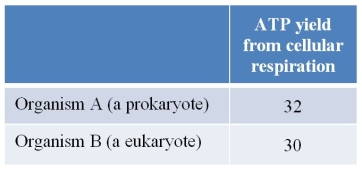Multiple Choice
Refer to the table below, showing ATP yield from cellular respiration in two different microorganisms.Yield is defined as the net number of molecules of ATP formed for every glucose molecule oxidized.  Which statement provides a possible explanation for why the yields differ?
Which statement provides a possible explanation for why the yields differ?
A) There is more opportunity for ATP to hydrolyze spontaneously before it can be used in the eukaryotic cell than in the prokaryotic cell.
B) The prokaryote has fewer respiratory proteins in its electron transport chain than the eukaryote.
C) NADH produced via glycolysis must be shuttled across the mitochondrial membrane in the eukaryote but not in the prokaryote.
D) Some ATP is used in the beginning steps of glycolysis in the eukaryote but not in the prokaryote.
E) The prokaryote has the capability of switching from aerobic to anaerobic respiration whereas the eukaryote does not.
Correct Answer:

Verified
Correct Answer:
Verified
Q23: An electron enters the _ to form
Q24: Refer to the diagram below, showing allosteric
Q25: In the first reaction of glycolysis, glucose
Q26: Which process converts glucose to pyruvate, generating
Q27: If an experiment based on the ones
Q29: Refer to the figure below, which provides
Q30: In yeast, if the citric acid cycle
Q31: The complete oxidation of pyruvate to carbon
Q32: _ takes place in the cytosol and
Q33: In the conversion of pyruvate to acetyl